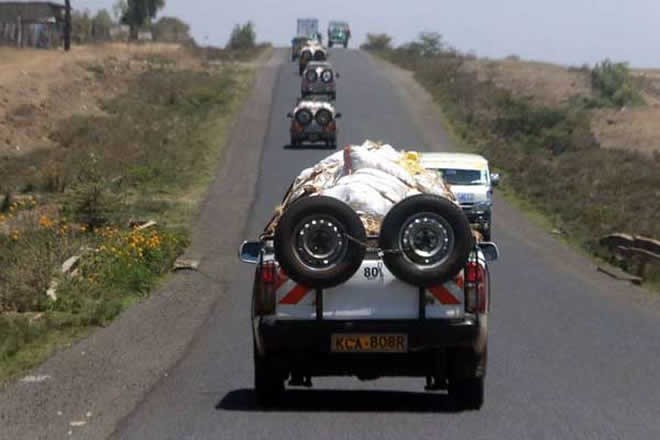
Wednesday September 20, 2017
By DAVID MUCHUI

Miraa transport vehicles along the Nyeri-Nanyuki highway on September 8, 2017. It's a boom for Kenyan miraa traders who have now foumd a lucrative market in Somaliland following a shortage resulting from conflicts in neighbouring Ethiopia which also sells the herb. PHOTO | JOSEPH KANYI | NATION MEDIA GROUP
Miraa traders from Kenya are cashing in on a shortage being experienced in Somaliland following the disruption of the business by conflicts in Ethiopia’s Oromia and Somali regions.
Ethiopia supplies most of the miraa consumed in Hargeisa, Somaliland and Djibouti but recent ethnic conflicts have cut off transport from the miraa growing areas.
In Ethiopia, miraa is largely grown in the eastern regions of Dire Dawa state and Harari region which are both about 200 kilometres from Hargeisa.
On Friday last week, BBC reported that dozens of people had died and at least 30,000 displaced in clashes across Ethiopia's Oromia and Somali regions in recent days while local media said the conflicts had affected business in eastern Ethiopia.
12 TONNES
Speaking to Nation, Nyambene Miraa Traders Association (Nyamita) spokesman Kimathi Munjuri said they are now delivering 12 tonnes of miraa to Hargeisa since last week.
He said they entered the market after traders and consumers in Somaliland protested over shortage of the herb that is highly prized in the region.
“Two aircraft are ferrying 12 tonnes of miraa from Nairobi since last week.
“We have been kept out of the market by hefty taxes and this is why we need government intervention for constant supply. We wish the national government can grab this chance to regularise the trading framework for us to continue with the supply,” Mr Munjuri said.
TAX
Miraa is a major tax earner for Somaliland and reports indicate that its sale generated 20 percent of the government’s Sh15 billion budget in 2014.
Somaliland is said to spend over Sh54 billion annually on Ethiopian miraa and the sector is a key source of employment in the unrecognised state.
In 2016, former Meru Governor Peter Munya visited Hargeisa to look for miraa market in a trip that turned controversial.
Mr Munya said Kenyan miraa is charged 300 percent duty while the Ethiopian khat is deducted 100 percent duty making it impossible to compete.
“The miraa market in Somaliland is worth about Sh40 billion which the Meru farmers should share in,” the former governor said.
He had sought to persuade the government of Somaliland to remove the obstacles that have hindered the export of miraa to Hargeisa.
Somaliland broke away from the Federal Republic of Somalia in 1991.
It shares borders with Djibouti to the west, Ethiopia to the south and Somalia to the east, and is yet to be recognised as a sovereign state.